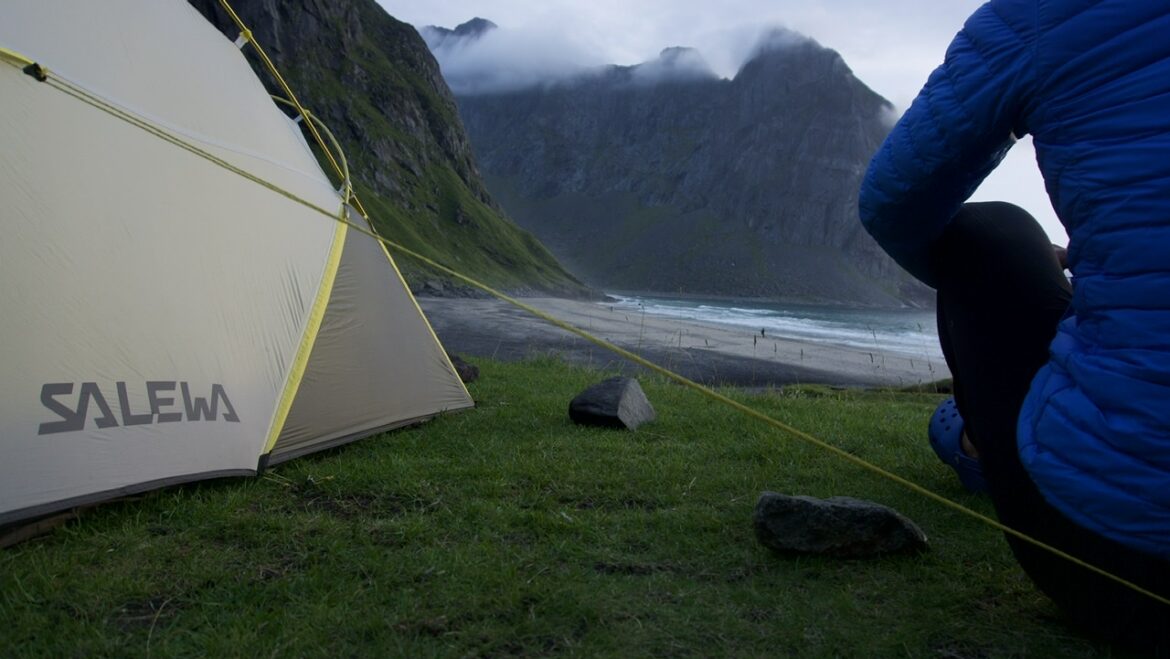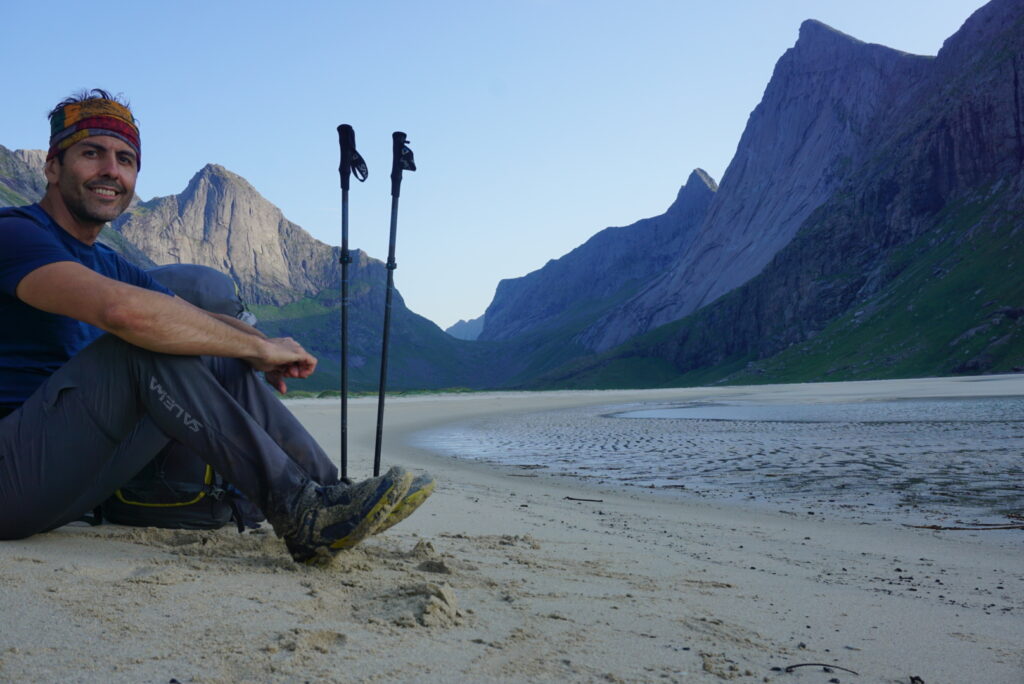Hiking is an activity that allows us to connect with the natural world and is beneficial for both our mental and physical health!
But Trekking, especially when combined with wild camping, is a travel EXPERIENCE worth living, which is inevitably leading us to a deeper connection with the natural world, our companions and -sometimes- a region’s culture!
However, the mountain environment – as nature in general – is a dynamic one, so any trip should be organised seriously, taking into account many factors such as:
- the season
- the weather forecast
- the area’s characteristics (eg climate, weather patterns, altitude, terrain, water sources, the availability of possible resupply points, the distance from the nearest roads / settlements / medical centres)
- the duration of our trip
- each individual’s experience, skillset, backpacking style, pace, goals
- group dynamics etc
Choosing the right gear is very important for our comfort and above all our safety and contributes (to some extent) to an enjoyable trip experience.
The following list is suggested for “3 season” backpacking in the Greek mountains (ie the period when there is no extensive snow coverage and no additional winter equipment is required) having in mind the backpacker who wants to travel lightly and safely.
Disclosure: I have to clarify that the products shown in the photos meet my personal needs (durability, reliability, lightweight and compact). I do not imply in any case that no other products exist with almost similar technical features!
–Backpack ( 40-60 litre capacity )
Lightweight (less than 2kg), with ergonomic design that offers freedom of movement, good load stabilisation and back ventilation. It is important to have additional storage areas ( at the sides and top) for quick access and be compatible with various water transportation systems.
Regarding the volume, in unsupported trips for example, I usually carry a 55 litre backpack for transporting gear and all my food supplies for up to 2 weeks.
Click HERE for how we organise our trekking backpack !
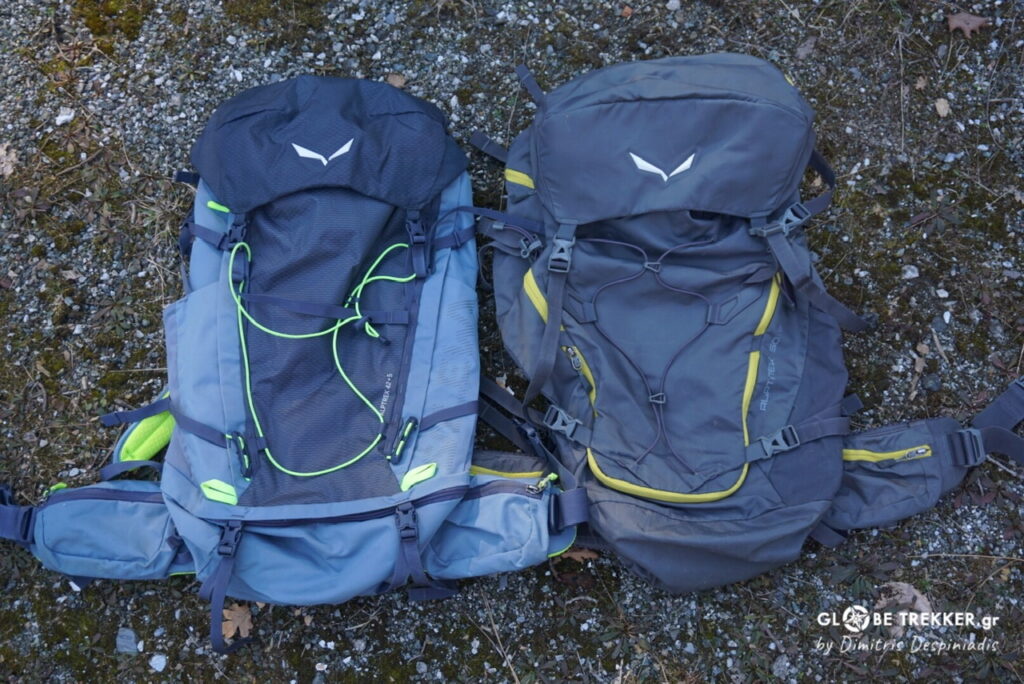
-Pack liner (waterproofing of backpack’s contents)
Raincovers are unreliable in driving rain and they tend to be blown by the wind, so it is advisable to put all gear in a waterproof bag inside the backpack. A very practical and cheap solution is a trash compactor bag. If you want something that will last for years, then it is worth buying a lightweight and waterproof pack liner.
–Walking poles
A Trekker’s “best friends”. Click HERE for the reasons why in detail!
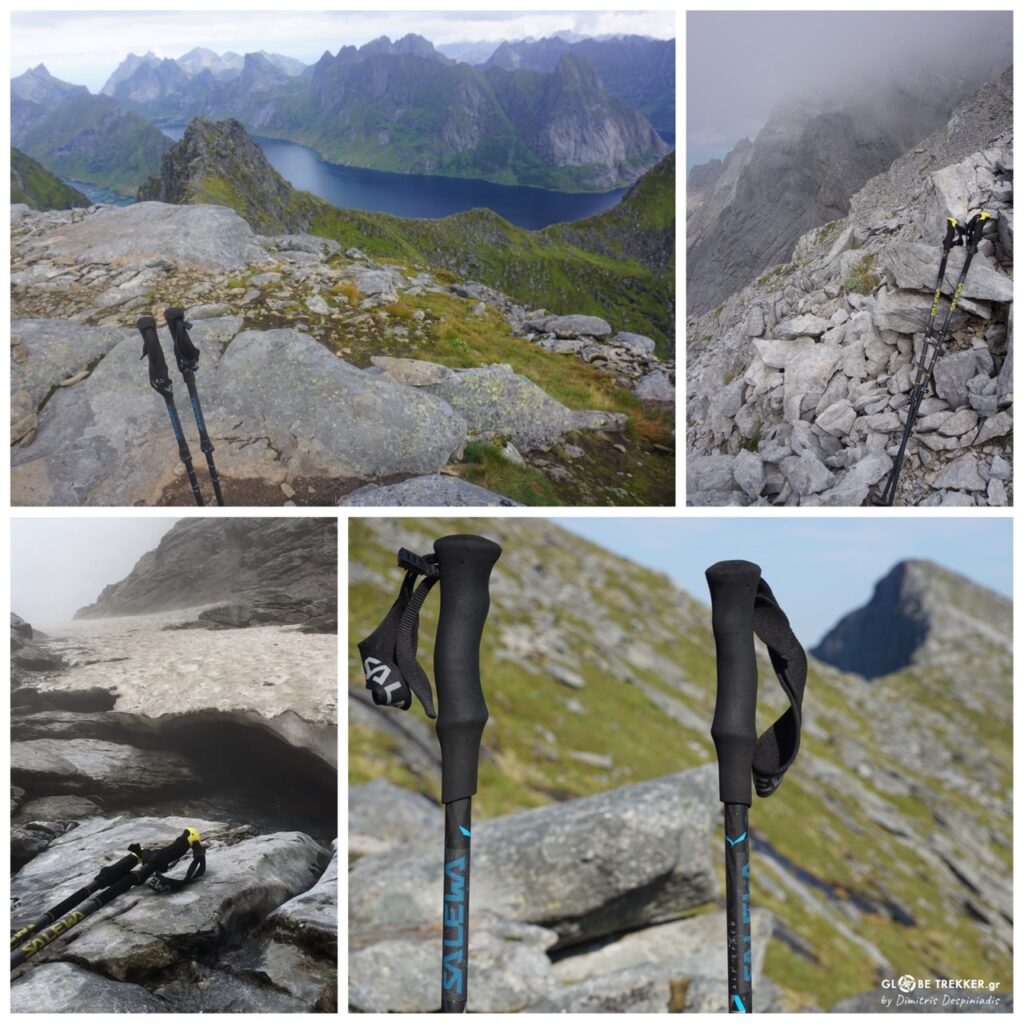
Sleep system
– “3 season” Tent
A lightweight (no more than 2 kg) one with ergonomic design, good ventilation and above all suitable for the adverse conditions encountered in the mountains. It is also important to meet our personal needs.
For my personal choice click HERE!
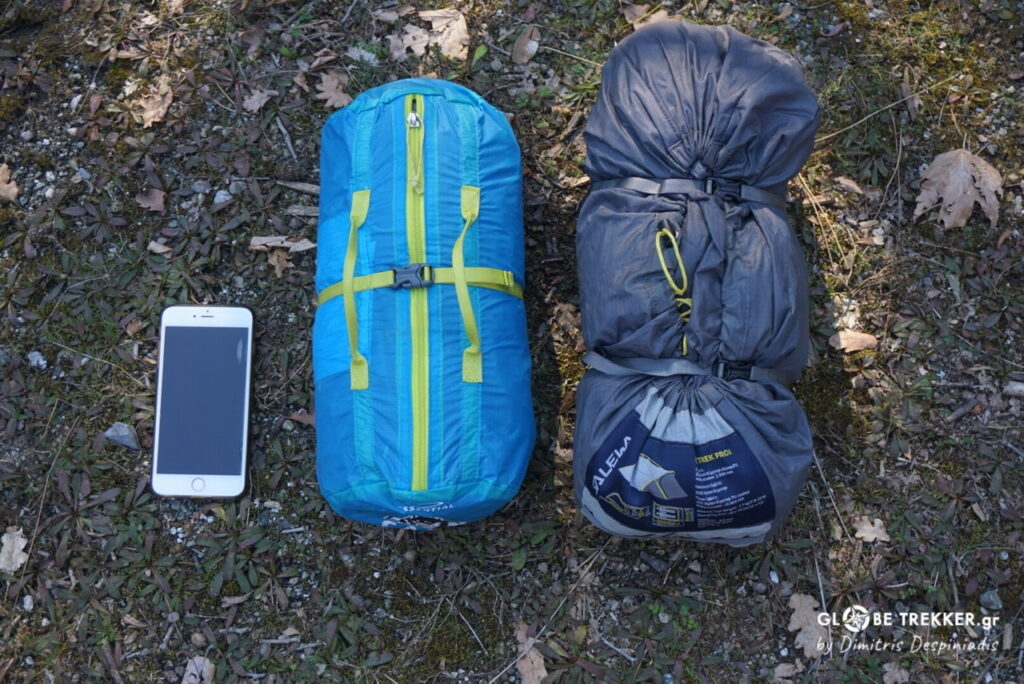
–Sleeping bag (or quilt) down / synthetic
Lightweight (0.70-1.10 kg). Down is lighter, less bulky and warmer per weight than any synthetic. Synthetic bags on the other hand are a better solution for very wet climates like HERE. A very warm (winter) sleeping bag is NOT practical for “3 season” use.
I usually prefer quilts for 3 seasons due to the wide temperature range in which they are suitable for and I can use them in combination with my insulation layers even on colder nights than their Comfort temperature (-2 C for the one in the photo ).
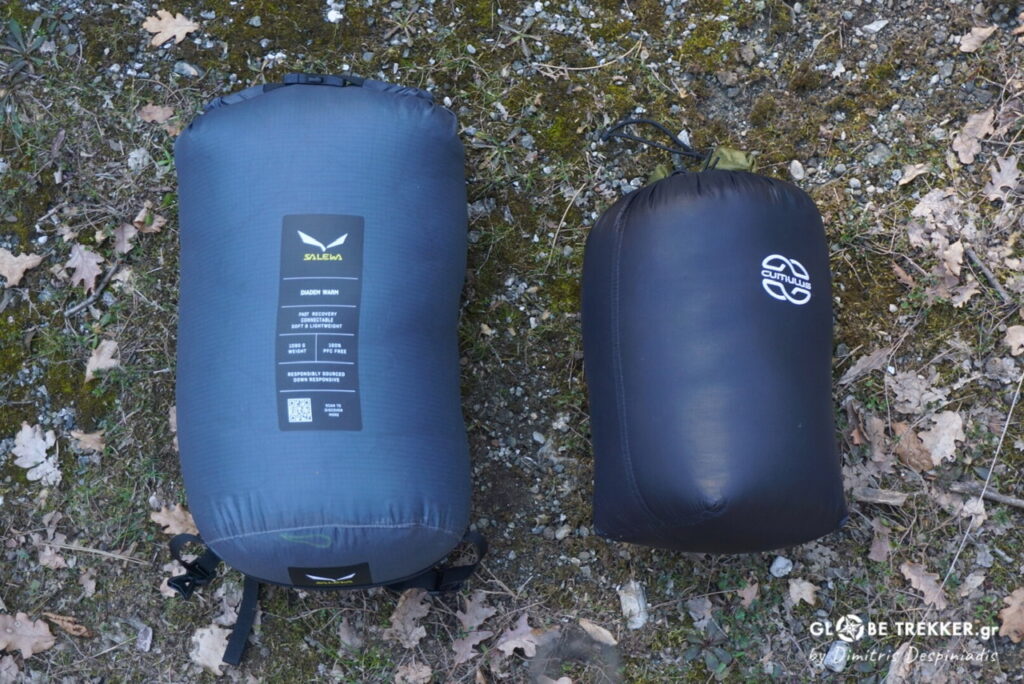
-sleeping pad (air or closed-cell foam)
Most of the heat loss during sleep in camp is due to our contact with the ground. Mattresses are doing just that. They insulate us from the ground.
A good sleeping pad must boast an insulation score (R Value) of 3.2 as a minimum. Air pads offer comfort that is … highly appreciated on multi-day trips while closed-cell foam pads are more practical on rough ground.

-pillow ultralight
Alternatively you can use a stuff sack filled with clothes.
Cooking system
-Stove Lightweight and reliable
for boiling water and cooking a simple meal. Some hikers go stoveless even in low temperatures (like my friend Argyris HERE). For others, like me for instance, it is a daily “ritual” to prepare and enjoy a hot meal at the end of a full day out in nature.
– Pot (Titanium or aluminium)
A quite versatile item that also serves as a bowl, mug and storage container.
-Butane-propane gas canister
-spoon
-lighter / fire starter or waterproof matches
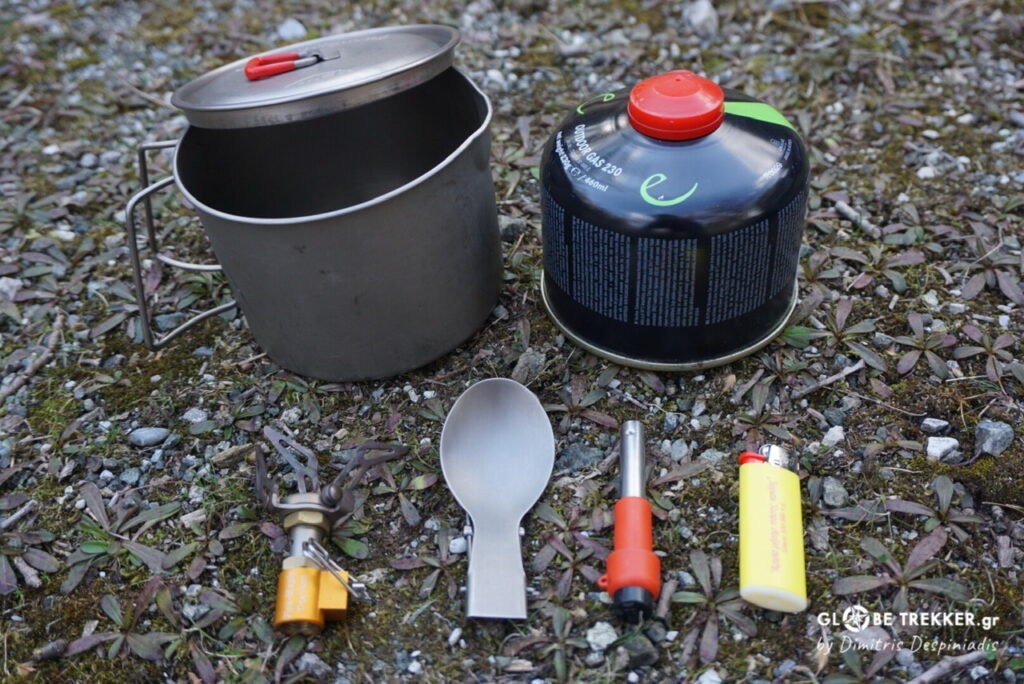
Food supplies
Prefer foods dense in calories and avoid bulky packaging. It is good to bring on the trip a variety of flavours for snacks (eg sweet-savoury) and textures (eg crunchy-chewy) such as sandwiches, sweets, nuts, dried fruits, etc. Ideally dinner should consist of a proper meal.
Due to the long duration of the trip, make sure that part of your supplies are of high nutritional value. Calculate how much you will need and don’t bring too much. Each person’s energy needs are different, but on a multi-day trip with many hours of hiking per day these needs are far increased in comparison to everyday life. Calculate 2500-4000 Kcal / day and 0.65-1.00 kg of weight / day carried in your backpack.
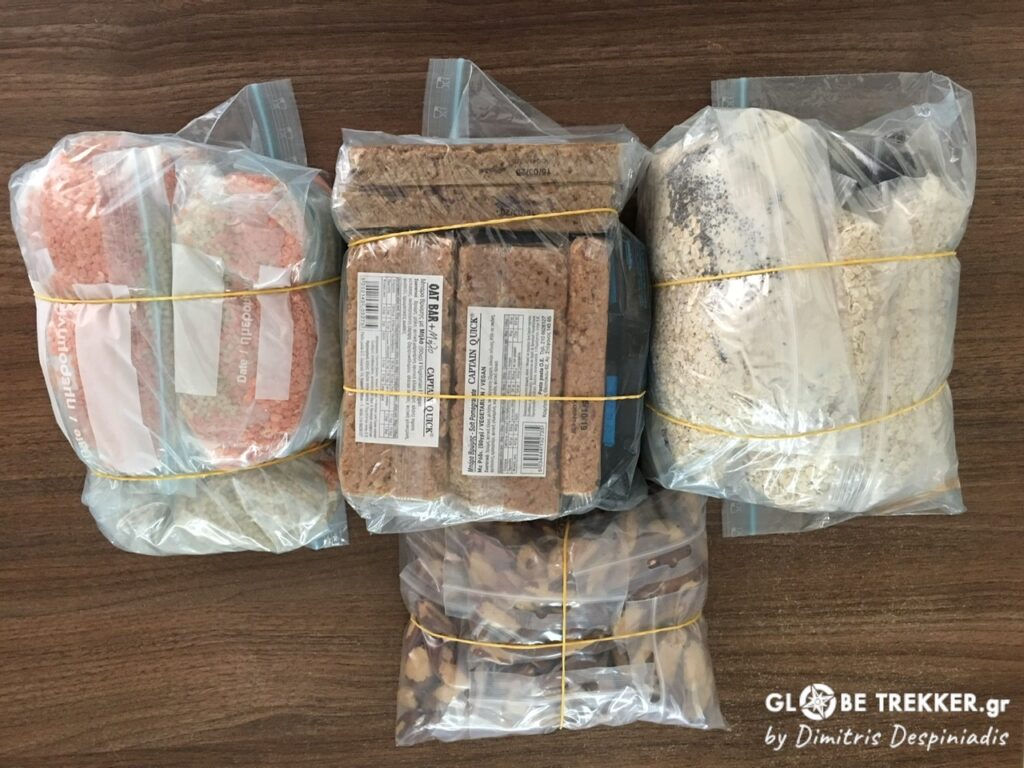
Water
-Water Storage (~ 1-2 litres) on a reservoir, flexible/ hard bottle
Make sure to start each day well hydrated and carry a sufficient amount depending on the conditions and after gaining reliable information (from a map, hiking guide, locals, etc.) regarding the availability of water sources or man-made infrastructure (eg open huts) where you can refill / buy along the way.
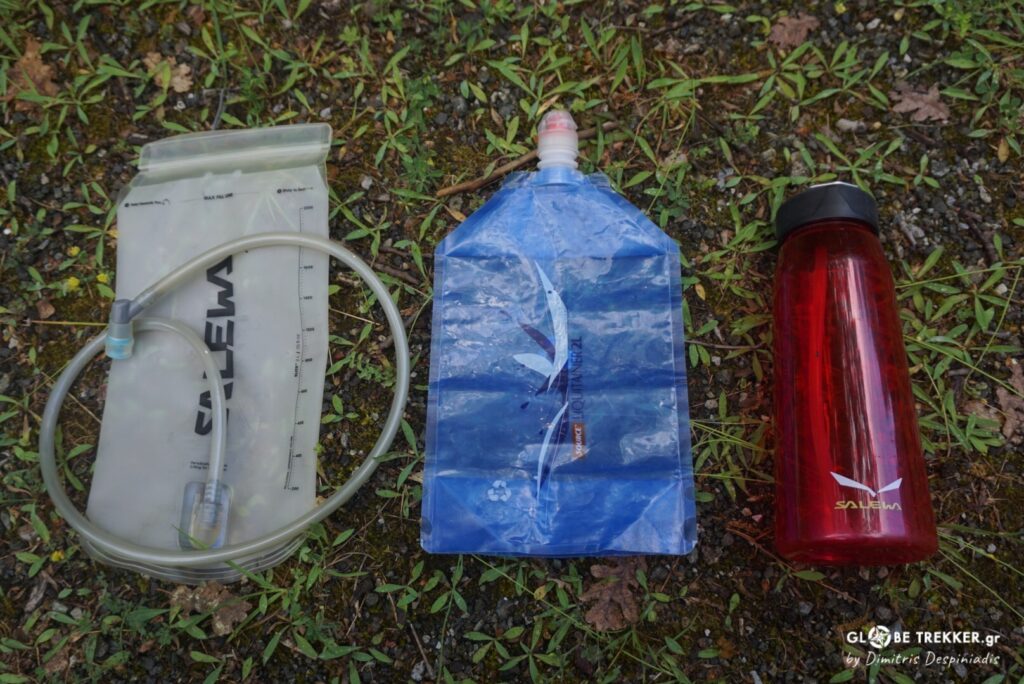
Water purification
Collect clear – and no smelly – water away from grazing animals. In some areas this is not always the case, so it is very important to use a purification method. I personally use the following:
-Steripen Adventurer
With UV rays, inactivates by 99.9% the DNA of bacteria, viruses and protozoa while not altering the taste to the slightest. It’s also Fast (purifies 1 liter in 1.5 minutes) and the solution I use in almost all my multi-day treks abroad (since I suffered giardia 15 years ago on a solo trip in Patagonia).
–Chlorine dioxide tablets
Also effective, but have a slightly noticeable chlorine aftertaste. The advantage of using tablets is their low weight and volume and they are a good choice on trips where weight reduction is a priority like HERE. Water is potable after ten minutes.
Footwear
-Hiking shoes/ boots or trail running shoes
suitable for the terrain encountered. Ideal WITHOUT Goretex (except at the beginning and end of the 3 season period) for better perspiration. Keep in mind that every kilo on your footwear is equivalent to carrying 5 kg of load on your back.
Footwear selection is a quite subjective issue and no matter how good reviews you have read about a specific brand or model, you should definitely try it before you buy! They may NOT suit you. Footwear must be comfortable and by no means narrow because your feet WILL swell.
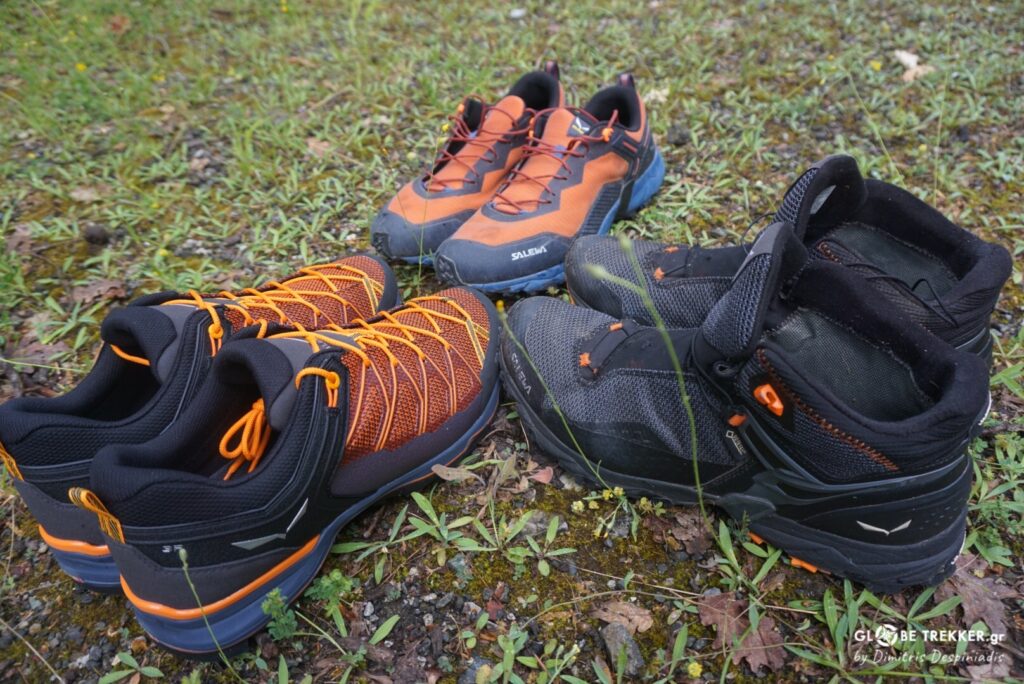
-Socks (x2) synthetic or woolen
(NO cotton)
** CROCS or sandals (Optional)
For rest. The former, in contrast to sandals, dry immediately and are super comfortable and light.
** Gaiters
They keep mud, dirt and pebbles out of your shoes.
** Microspikes
in case snow covers even small exposed sections along the route ( collecting reliable relevant information is part of the trip planning ).
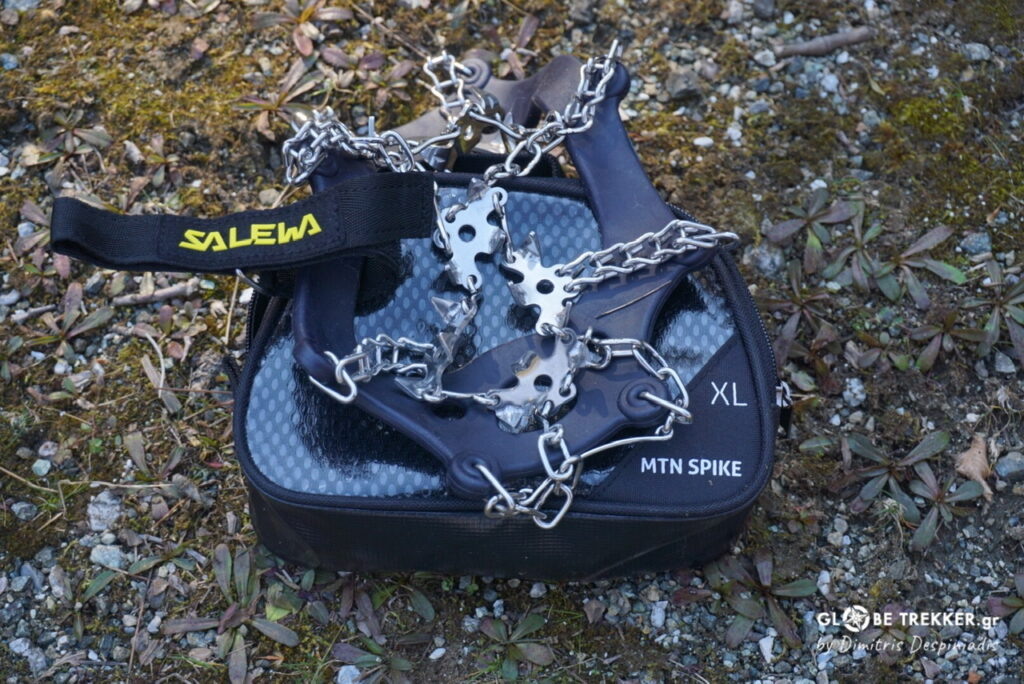
Clothing
-synthetic or woolen underwear (x3)
-hiking pants/ shorts that dry quickly or leggings or running shorts

-Baselayers (x2) lightweight short / long sleeved synthetic or woolen
that dry fast (NOT cotton)
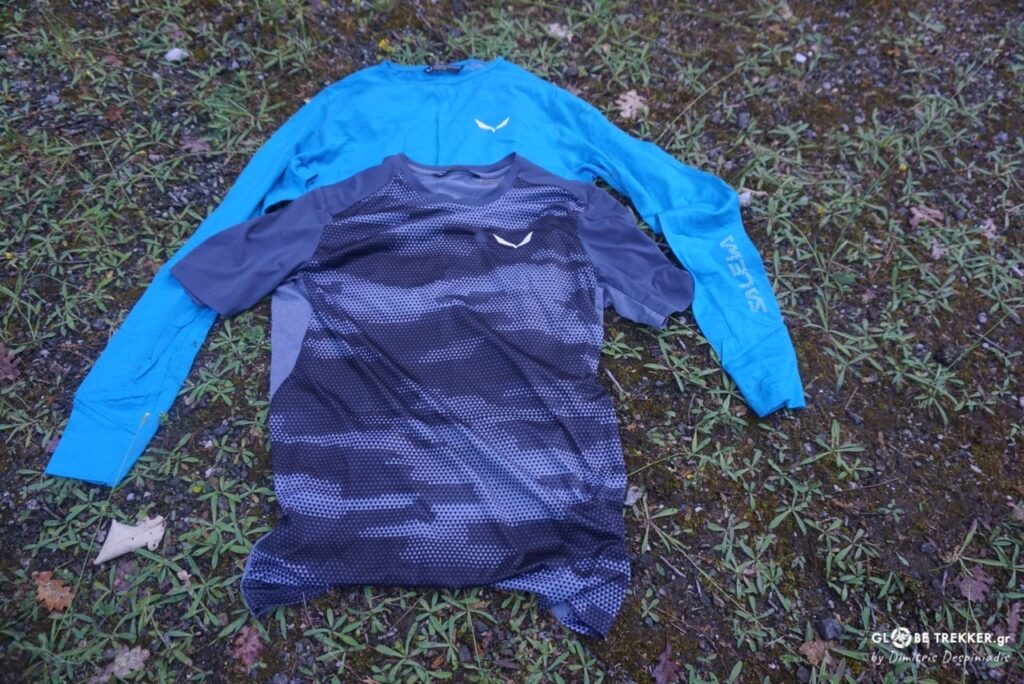
Insulation
-Thermal Underwear (pair)
–gloves
(windproof with good breathability that do not limit dexterity),
–warm beanie and extra pair of warm socks for the extremities
-Lightweight down or synthetic jacket
for breaks, camp and even sleep if needed.
** lightweight fleece
(Optional at the beginning and end of this period).
Click HERE for the reasons why !

Rain protection
-Waterproof jacket
A Lightweight one that dries quickly and has an adjustable hood with pre-shaped visor. Indicatively, a raincoat for mountain hiking should boast a minimum of 10,000mm (10k) of waterproofing and 10,000gr / m2 / 24h (10k) of breathability.
-Waterproof lightweight pants
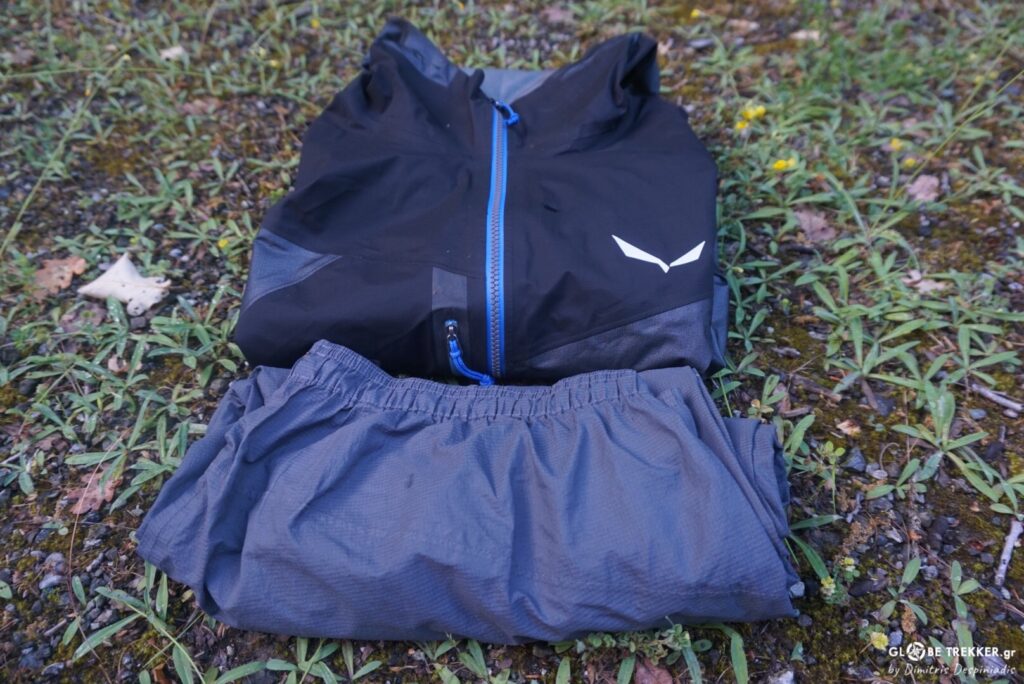
Contact
-Mobile phone
(mostly in flight mode for battery saving). The emergency number in Greece is “112”.
On a trekking trip it is good to carry a Power Bank (portable charger).
On the contrary, I do NOT consider solar panels practical for the activity (as I found out with well-known models even HERE)!
Navigation
-printed topographic maps and compass
and ability to use them properly ( in the photo for example are shown Printed maps for HERE )!
-GPS device or mobile phone with topographic map installed in a GPS app
that shows our position even when we are offline
-Route description
from hiking guide / notes in printed / electronic form
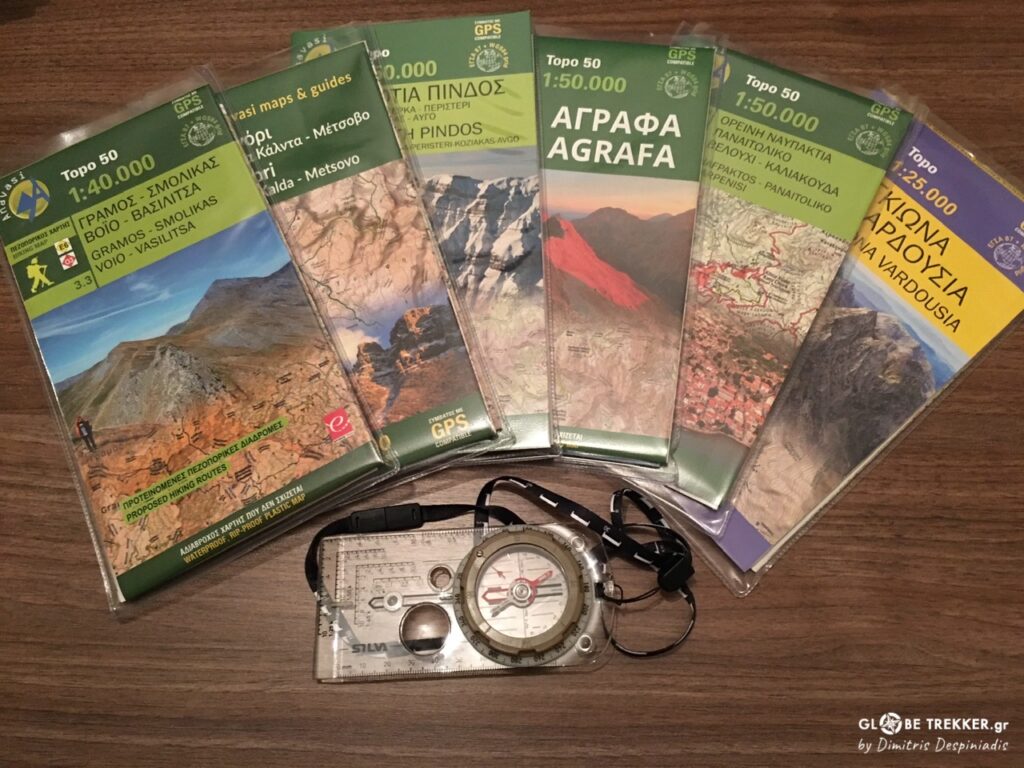
Sun protection
–hat
-sunglasses
-sunscreen with a high SPF protection index
for the exposed parts of the body
-lip balm
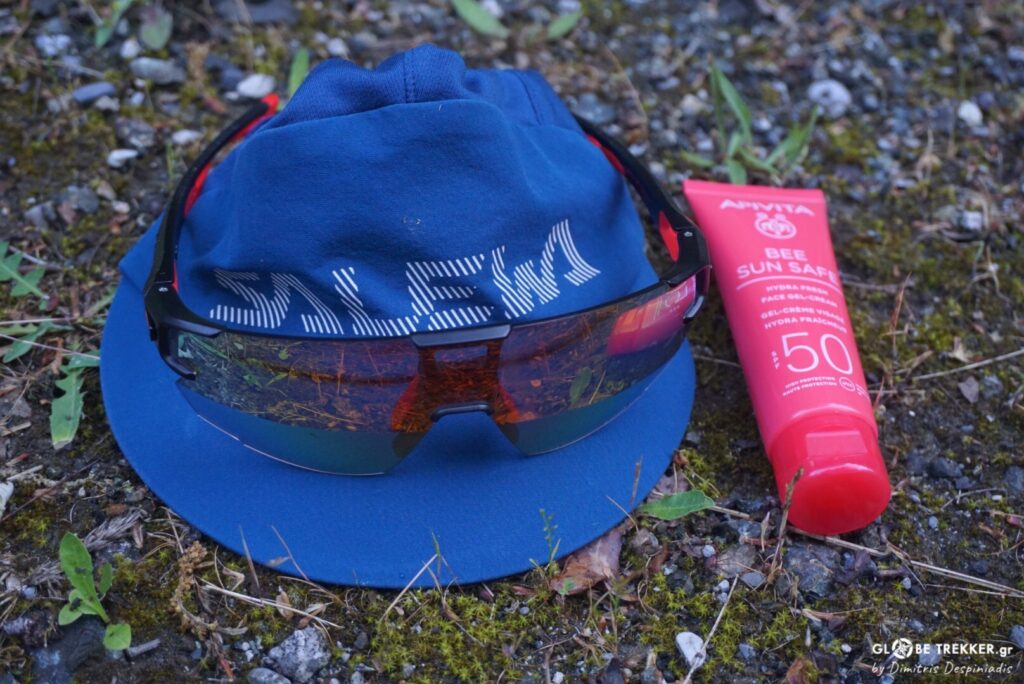
Emergency equipment
–First Aid kit (small personal)
A plethora are available on the market but you can organise it by yourself too if you wish.
Emergency Blanket, Elastic Bandage, Homeostatic Spray / Cotton, Saline, Antiseptic Wipes (for Wound Cleaning), Antiseptic Paste, Disposable Surgical Gloves, Sterile Gauze in Various Sizes, Sterile Gauze for burns, triangular bandage, Steri-strip for stitches, Compeed for blisters (in various sizes), Hansaplast, micropore medical tape, Almora for dehydration, Antihistamine gel, Paracetamol Pills (x4), ibuprofen [anti-inflammatory] Pills (x4) and Pills for diarrhoea (x4).

Note: In case you do NOT intend to camp in the open by staying in huts or hostels (where they exist), keep in mind that in the mountains you should ALWAYS carry a few but potentially life-saving small items, just in case get immobilised out there!
– EMERGENCY SHELTER
A simple Emergency blanket is not enough! Try to see how it “blows” in the air…
Thermal bag
A Highly practical and cheap solution!
It should ALWAYS be on the bottom of our backpack… even if you never need it! Lightweight and with minimal volume.
You enter the bag leaving only your face uncovered. Waterproof and windproof, it retains 90% of your body’s thermal radiation. You WILL sweat, but who looks under comfort when survival is at sake!
Bivvy bag
A MUCH better – if affordable – solution!
Very lightweight. It reflects 90% of our body heat. It has excellent perspiration and we can use it -apart from emergency use – in combination with a sleeping bag and in planned bivouacs under the stars!

-Headlamp with extra batteries
International distress signal: flash 6 times, pause for one minute, repeat… until someone finds you.
–Whistle
International distress signal: 6 whistles, pause for one minute, repeat… until someone finds you.
-lighter/waterproof matches or firestarter
(mentioned above) for lighting a fire.
“Leave No Trace” kit
-hand sanitiser, trowel , toilet paper / tissues (NO baby wipes), ziplock bag.
-bag for our trash
Don’t leave NOTHING behind in nature including organic waste like banana peels!
Even if there are bins / baskets at the trailheads, keep in mind that trash is not collected so often from there and can attract animals. It is far better to dispose them later in a village / town.
Personal hygiene
(all in small quantities / packages)
– Hand sanitiser
– Toothbrush and Toothpaste
– Liquid biodegradable soap
– Cotton swabs
– Deodorant
– Tissues and Baby Wipes
Towel
Lightweight with microfibres that dries quickly
Repairs
-Swiss army knife (basic )
for example Victorinox Classic
-Gorilla / Duct tape
-Tire-ups
-Needle and thread
Personal items
-ID card / passport
-credit card
-cash
Storytelling
-Photo Camera / Action camera
-notebook and pen
IMPORTANT: You should ALWAYS inform a trusted person in writing about the trip’s plan!
Which route will you follow? Will you be alone? And if not how many of you and who? When do you expect to return at the latest? Both during (if possible) and after the end of the trek it is good to inform the person about your progress.
I hope you found this article useful and would like to wish you Safe and Enjoyable Trekking/ Backpacking trips in the mountains! 😊✌️
PS: A useful Dayhike Gear List can be found HERE!



